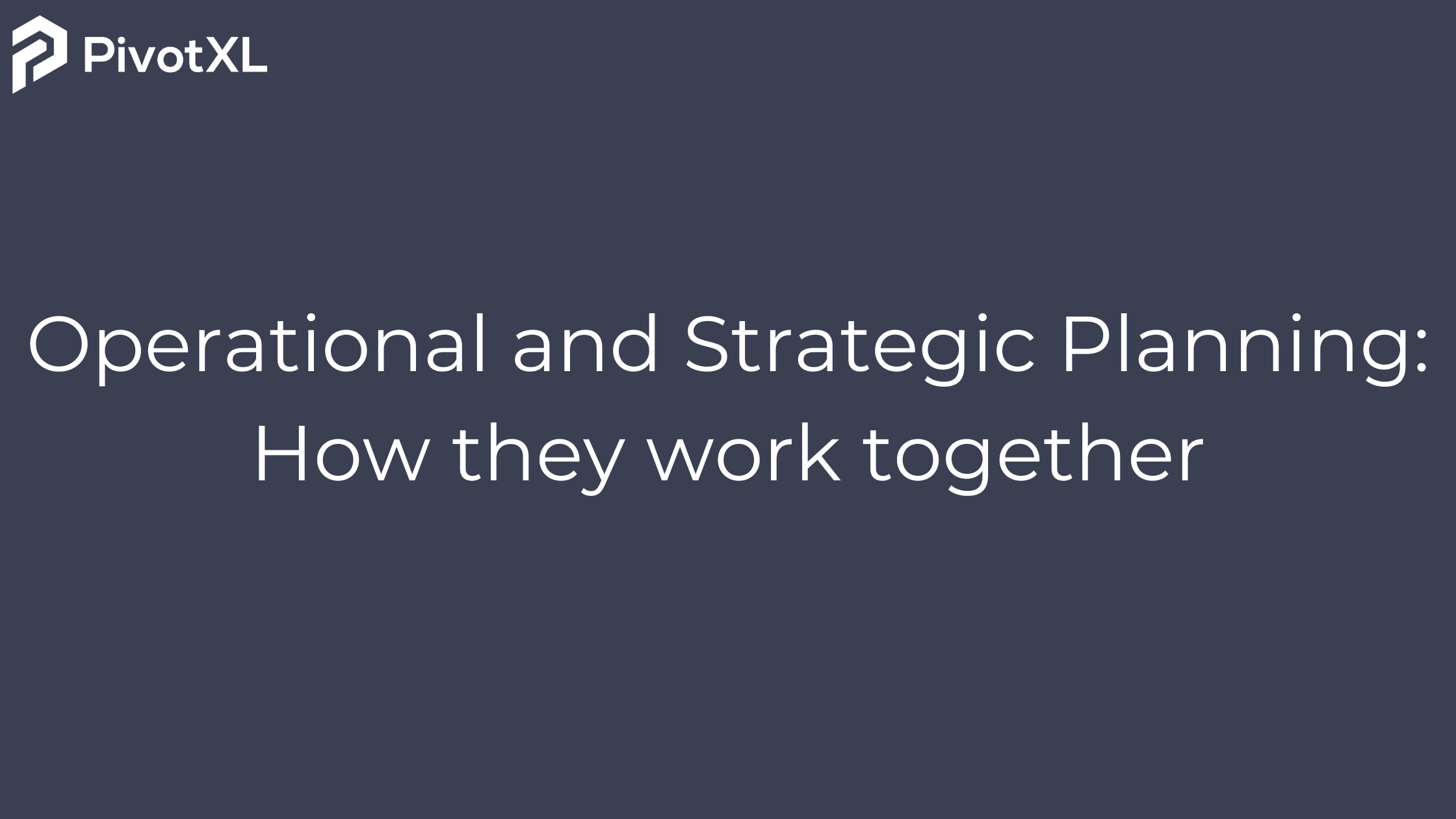What Is Strategic Planning?
Strategic planning is a long-term plan for success that focuses on specific goals designed to grow the business over several years. Have you ever had a dream for your company, a vision that feels as personal as a life goal? Of course you have, because the process requires you to hit that target with a deliberate planning process that is both operational and strategic.
Just as any personal goal requires you to transform yourself—from a couch potato into a marathon runner—you need a roadmap for the long journey ahead. In business, this means a company must lay out a multi-year plan that not only aims to increase revenue but also to grow headcount, all through a rigorous process. It takes an external perspective by analyzing competitors, the economy, and customer feedback, while also ensuring an internal focus. This high-level, big-picture thinking is typically managed by the CEO and board members, ensuring that the vision remains the guiding light and foundation that keeps everyone focused on the ultimate prize.
How Does FP&A Fit Into This?
Financial Planning & Analysis (FP&A) plays a crucial role in this framework. Financial data serves as the bedrock for determining how realistic any goal may be. The finance team is therefore integral to the planning process and must be fully embedded within the functions of the business. Most goals focus on revenue—be it increasing cash flow or hitting a particular sales figure—and require detailed financial analyses that spotlight potential obstacles. Financial insights drive the initiatives and help secure investor buy-in, all while reinforcing the underpinnings of the plan.
What Is Operational Planning?
If strategic planning is akin to setting the goal of running a marathon, then operational planning is the rigorous training regimen that makes that dream possible. You wouldn’t show up at a marathon without a proper training plan, just as you cannot achieve a vision without dedicated execution. This approach is where the nuts and bolts are hammered out to transform the concept into everyday reality. Day-to-day tasks and details that bridge the gap between a concept and execution are meticulously planned and managed.
The plan acts as the North Star, while the operational plan provides the detailed, year-by-year roadmap. In some cases, when a plan spans five years, the execution is broken down into annual cycles. In larger organizations, there can be multiple plans running concurrently, each reinforcing the overall direction.
A Working Operational Planning Definition
Operational planning (OP) is the implementation of strategic plans and objectives designed to achieve specific business outcomes. Without effective execution, even the best plans remain unfulfilled.
How Does FP&A Fit Into Operational Planning?
Financial management, with its roles in both execution and overarching vision, provides a holistic view of the business that is critical for effective planning. The finance team contributes by developing risk strategies, setting operating budgets, and eliminating unnecessary spending—all of which support the overarching objectives. Therefore, FP&A must have a prominent seat at the table, aligning every detail with the overall vision.
A Word on Tactical Planning
Beyond the broad, long-term vision and the detailed day-to-day actions, there is tactical planning—a short-term focus that addresses specific business challenges. While the plan outlines clear goals, the tactical plan zeroes in on deliverables. Think of it like having a personal trainer in addition to your marathon training plan: the tactical approach fine-tunes and constantly adjusts the details to ensure that milestones are met.
For instance, if your plan sets a goal to increase headcount by 50%, the tactical plan breaks down the steps: crafting interview questions, hiring recruiters, sourcing candidates, and scheduling interviews—all in service of the objective.
What’s in a Strategic Plan?
Every company’s approach is unique, but several key elements are common to all robust plans. Even though models like OKRs and balanced scorecards are popular, the core components remain similar across every process.
Vision and Values
Your mission statement is a collaborative document that defines what the company is about and what values drive its success. This vision is aspirational and is meant to create buy-in among employees so that they rally behind a shared goal. No single person can craft a vision alone; it requires input from diverse stakeholders to ensure the alignment of the entire organization.
Key Goals
Once the vision is established, the next step is to set key goals. These targets—often set as FAST goals such as specific revenue numbers or turnover percentages—must be bold yet realistic. They need to be directly linked to the vision and values and should be objectively measurable. Financial experts play a role here by defining the company’s financial security and setting targets from that baseline.
Action Plan
The action plan spells out exactly how the goals will be achieved. While the high-level document provides the big picture, it is the detailed plans that break down the steps into a clear, actionable roadmap. Even though the primary plan might not dive into every detail, it must outline enough strategies to signal a clear pathway forward.
What’s in an Operational Plan?
Once the primary plan is firmly in place, the operational plan must follow suit. Below are the core aspects that every effective planning process must include:
Objectives
The overarching vision informs the objectives. These objectives are influenced by the budget, available resources, and key stakeholder responsibilities—all of which must align with the goals.
Details
An operational plan is, by nature, detailed. It gets into the minutiae by establishing clear, actionable steps, timescales, and resource allocations. This detail is crucial because it translates the vision into reality.
Stakeholder Responsibility
Clear assignment of responsibility is vital to avoid any confusion. This step ensures that every team member understands their role in executing the plan, fostering a sense of accountability and ownership.
Strategic and Operational Planning Example
It can sometimes be challenging to differentiate between various business plans, so let’s explore an example that underscores both planning approaches in practice.
Strategic Plan Example
Consider a tech scale-up company, JustTech Inc, which has reached 100 employees and generated over $5 million in revenue. At this critical juncture, a three-year plan is essential. After consulting key stakeholders across finance, HR, and operations, the company sets forth its goals:
- Achieve $20 million in revenue
- Expand to 250 employees
- Launch two new product lines
From a financial standpoint, the initiatives for these goals might include:
- Developing a multi-year financial plan to reach the $20 million revenue target
- Collaborating with HR to create competitive, benchmarked compensation plans
- Conducting financial analysis for the new product lines
Key performance indicators—such as revenue growth, employee headcount, and return on investment—are then established to monitor success.
Operational Plan Example
These three goals are then broken down into objectives and actionable strategies:
- To achieve $20 million in revenue:
- Increase the sales and marketing budget over the next year to capture new markets
- Improve customer support to retain existing clients, ensuring stability
- Offer product bundle sales to increase the average deal size through efficiency
- To grow headcount to 250 employees:
- Develop a hiring plan with a prioritized list of urgent roles
- Create a robust onboarding program for remote employees, broadening the candidate pool
- Implement an employee incentives scheme to boost morale and retention
- For launching two new product lines:
- Conduct market research to identify product opportunities
- Assemble a cross-departmental product development team
- Develop a detailed roadmap for each product line, ensuring feasibility
Each objective is assigned budgets, timescales, and specific stakeholders, ensuring that every ambition is met with a corresponding action plan. The interconnection between these plans means that, for example, to meet revenue targets, the company might need to adjust its headcount in the sales and marketing team beyond initial estimates.
The Ultimate Process for a Strategic Plan
There is no one-size-fits-all approach to a plan—every company and its goals are unique. However, the following key steps form the backbone of any successful planning process:
- Gather the key stakeholders. A successful plan demands that all varied voices be heard. This typically includes the executive board along with managers, external advisors, and other leaders who contribute to the overall vision.
- Do your research. For the plan to work, you must assess both internal strengths and external market conditions. Techniques such as SWOT analysis, gap analysis, competitor research, and customer feedback provide invaluable insights that drive decisions.
- Work out the goals. Using the research gathered, establish goals that are bold, impactful, and aligned with your capabilities. Prioritize the goals that promise the highest impact and feasibility in the long term.
- Plan of attack. Develop an action plan that outlines each goal’s initiatives, tactics, and required steps. Whether it involves marketing campaigns, IT upgrades, or partnerships, this plan ensures that every move is deliberate and aligned with the overarching objectives. Define key performance metrics to regularly review progress.
- Monitor and adjust. Regular reviews are essential to the success of any plan. These sessions offer opportunities to reflect on progress, reassess goals, and make necessary adjustments. Depending on the company’s stage—be it a startup or an established enterprise—these reviews might be monthly or yearly, ensuring that every milestone is met with effective action.
How to Create an Operational Plan
With your plan in hand, the next step is to move the needle through a detailed execution plan. Follow these steps to ensure that your actions fully support your objectives:
- Break down the vision and goals. Dissect the plan into actionable steps. Identify which departments will drive each goal and examine current assets, missing resources, and any financial risks that might affect the objectives. This process ensures that every decision is rooted in the vision.
- Get a budget in place. Develop a detailed budget that aligns with each department’s needs and the objectives. Allocate funds based on expected ROI and the necessities required to fulfill the plan, while also planning for unexpected expenses.
- Set targets. Each objective needs a measurable target to keep progress on track. The targets should be realistic enough to maintain motivation but challenging enough to achieve the ambitious goals. Assign responsibility to specific teams and leaders to ensure every detail is executed in service of the vision.
- Review regularly. Schedule routine reviews to assess whether the plan is effectively contributing to the goals. These sessions are critical for adjusting tactics and ensuring that the targets remain in clear focus. Open communication and data-driven insights help fine-tune practices and approaches.
Best Practices for Integrating Operational and Strategic Planning
Integrating planning requires a deliberate, collaborative approach that aligns all goals and fosters cross-departmental synergy. Here are some best practices to achieve this integration:
- Establish clear objectives. Both planning efforts must be aligned with the overarching goals of the organization. Clearly define the desired outcomes to maintain unwavering direction and focus.
- Foster cross-functional collaboration. Encourage departments such as finance, operations, marketing, and sales to work together. This collaboration enhances insights and execution, ensuring that diverse perspectives are incorporated into every decision.
- Implement integrated planning tools. Invest in technology that enables seamless collaboration, data sharing, and real-time updates. Such tools support the framework while streamlining processes across the organization.
- Develop key performance indicators (KPIs). Define measurable KPIs that align with the objectives. These metrics help monitor progress, ensuring that every initiative contributes directly to the vision.
- Establish feedback loops. Regular feedback from stakeholders is crucial for refining plans. Solicit input on proposed initiatives to ensure they remain aligned with the goals and adjust tactics as necessary.
Future Trends for Operational and Strategic Planning
The future of business planning is increasingly defined by innovations that enhance both foresight and execution. Developments in predictive analytics are revolutionizing planning by enabling businesses to better predict, evaluate, and make decisions. Technological innovations such as artificial intelligence, machine learning, and prescriptive analytics are reshaping how companies approach challenges and efficiencies.
Machine learning algorithms sort through massive datasets, improving the precision of forecasts and driving data-driven decisions, while artificial intelligence fosters foresight by enabling autonomous decision-making and real-time responses. Prescriptive analytics goes a step further by providing actionable suggestions to maximize outcomes. In this evolving landscape, organizations must emphasize data governance and ethics, embrace change, and invest in advanced tools that bolster both planning and performance.
Conclusion
This comprehensive overview explains how planning processes work together to guide a business to success. By integrating visionary goals with detailed execution, every company can create a roadmap that transforms ambitions into tangible results.




